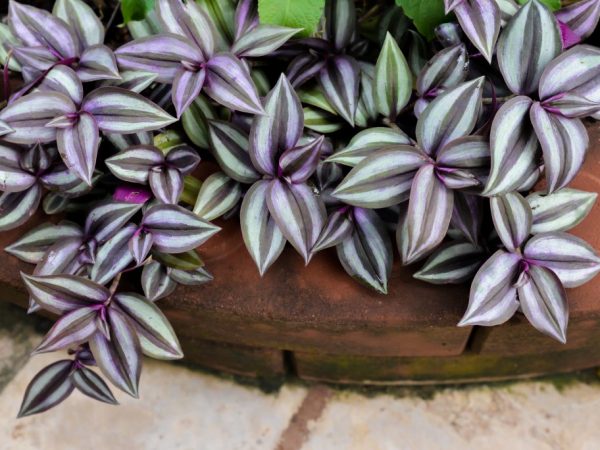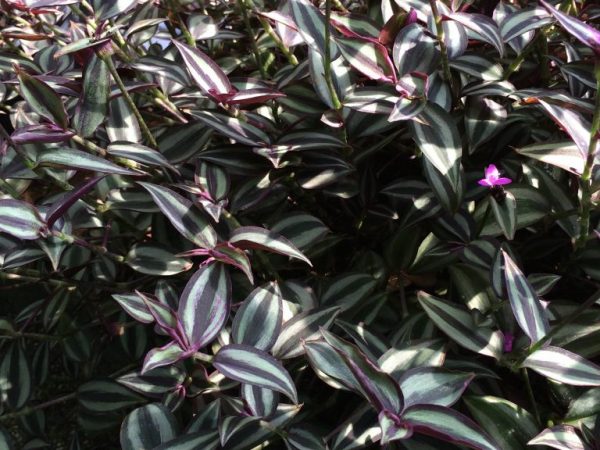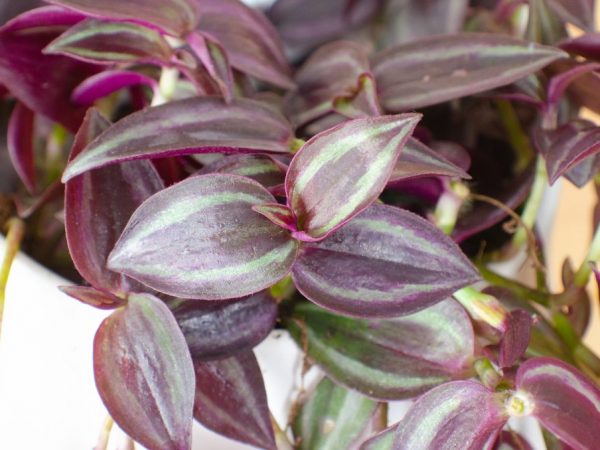Tradescantia Zebrina - rules of care and breeding features
Ornamental Tradescantia Zebrina, or striped, native to Mexico and Guatemala, is very popular with flower growers. An evergreen plant with variegated foliage adorns any living and office space, and does not require much maintenance. Consider what a flower looks like, what conditions it needs for full growth and development.

Tradescantia Zebrina
Description of the plant
The Latin name for the flower is tradescantia zebrina. Commeline family.
A herbaceous evergreen perennial grows rapidly - the length of the stems can reach 1.8-2 m, the height is no more than 15 cm.
The leaves are sessile, oval with pointed tips, 7-10 cm long. The color is varied - the inner side is purple, the outer side is green with thick silvery and thin purple stripes.
The plant blooms with small three-petal inflorescences of pink, snow-white or purple tones.
The flowering period is in spring and summer.
Varieties
Indoor Tradescantia has several ornamental varieties that are appreciated in home gardening.
- Hanging, or dangling (often called the "Wandering Jew"). The most popular type, it has healing properties. The leaves are large, ciliate, reddish-green with silvery longitudinal stripes. Below the leaf is purple-red.
- Red Hill. A beautiful plant with emerald leaves, bronze tint and gray stripes. Purple on the underside. This hybrid is grown in hanging pots, baskets. It belongs to the ground cover varieties, therefore it is suitable for growing in a flower garden.
- Setcreasea purpurea (Purpura, or purple heart). A lush plant with numerous stems, densely covered with dense leaves. The surface of the leaf plate is reddish-olive, contains slight pubescence, the underside is glabrous, purple.
- Flocculosis (flocculosa). Differs in white leaves with fine pile.
Purchase and adaptation
You can buy striped Tradescantia in one of the flower shops. To get a strong and healthy plant, you need to carefully examine its aboveground part:
- leaves and stems of a rich color;
- there are no signs of infection with diseases and pests - yellow, black or red specks, growths;
- earthen lump without acidification and mold.
The condition of the root system is also important - through the drainage holes it will be possible to determine if the flower has health problems. In patients with Tradescantia, the roots are rotten, covered with mold, of an uneven tone with elements of black or white spots.
After purchase, the plant needs to be given time to adapt - it is quarantined for 20 days. During this time, he will get used to room conditions.
Landing rules

Planting a plant in spring
It is better to plant in spring and before new leaves begin to bloom.For planting, use a purchased substrate or prepared independently according to the recipe described above.
The pot is taken from ceramics or plastic, at least 10 cm high, always with drainage holes at the bottom. A couple of handfuls of expanded clay are poured, then half filled with fertile soil. The roots are lowered, straightened, covered with earth to the top, slightly crushed around the stem, watered.
After planting, the flower is placed in a warm room with diffused daylight.
A transplant is necessary in the following cases:
- a purchased flower after three weeks of quarantine, since it will develop poorly in the store land;
- homemade tradescantia every three years so that they do not lack space and nutrients;
- in case of damage to the root system by rot, pests.
Before the procedure, the plant is watered abundantly, which makes it easier to extract the roots with minimal injury. Take a pot 2-3 cm in diameter larger than the previous one, fill it with drainage, fertile soil mixture. They transfer a lump with roots into a container, add the earth to the top, moisten it.
The necessary conditions
Variegated Tradescantia prefers to grow in a sunny location with diffused daylight protected from direct rays.
The best place would be a window sill on the west, southwest or east side.
When grown in the northern part of the house, the leaves turn pale and the flower itself develops slowly.
The soil is light and loose. You can use a commercially available decorative deciduous substrate or prepare your own soil mixture by mixing coarse sand with peat and perlite in a 1: 2: 1 ratio.
Microclimate
The duration of a light day is at least 10 hours. Diffused lighting. In winter, artificial lighting is required.
You can determine the lack of light by the faded foliage, which becomes monotonous. Shoots also begin to stretch upward.
The flower can be kept at room temperature - 21-25 ° C.
He loves fresh air, but cannot stand drafts. Therefore, in autumn and winter, at the time of airing, it is transferred to another room.
Humidity should be moderate - about 65-70%.
- In the warm season, this condition is provided by frequent spraying of the crown - every 3-4 days.
- In winter, sprinkling is rarely carried out - once a month to wash off the dust from the leaves.
If it's too hot, you can put an open container of water next to the flowerpot, and also place the plant on a pallet with damp pebbles or expanded clay.
Care features

You need to monitor regular watering
Proper home care will help you achieve maximum decorative effect from this plant.
Watering
You need to moisten the flower regularly, its further growth depends on it.
The frequency of watering is adjusted according to the season:
- in spring and summer - every 3-4 days;
- in winter - every 7 days.
At the same time, it is important that the surface layer of the soil dries out, since frequent waterlogging can cause the development of root rot.
After each watering, light loosening of the soil is carried out to ensure full access of oxygen and moisture to the roots.
Pruning
The creeping plant does not need to form a crown, therefore, only a sanitary haircut is carried out every spring.
All stems and leaves that have dried or turned yellow must be removed, since they are a source of infections and a good environment for pests to appear.
For trimming, a sharp and sterile instrument is taken to prevent infection.
Reproduction methods
Indoor Tradescantia Zebrin can be multiplied by several methods, which one to choose is up to you.
Cuttings
Cuttings are cut during spring pruning - they take strong and healthy shoots from an adult plant. The optimal length is 10-12 cm.
For quick rooting, they are dipped into a vessel with water with the addition of Epin. Keep in such an environment until roots appear on the cuttings.This usually takes 2-2.5 weeks.
Rooted seedlings are planted in the same substrate as adult specimens. For planting, take plastic containers or seedling boxes. They are planted to a depth of 3-4 cm at an angle, watered. They create a greenhouse effect by covering the seedlings with transparent film or glass.
Every day they are ventilated, if necessary, irrigated from a spray bottle. As soon as new leaves appear on them, the shelter can be removed. The grown flowers are planted separately in flowerpots.
Dividing the bush
Usually, this method is used when you need to transplant and rejuvenate an old plant. It is abundantly moistened after an hour, when the earth is soaked, remove and lower the lump with roots into a basin of water.
After the remnants of the soil are washed off, the root system is taken out, dried, all dubious roots are removed, then the plant is divided into parts so that each one has one shoot and 2-3 root processes. Places of cuts are covered with charcoal.
Seated in separate pots, watered.
Seeds
This method of reproduction is rarely successful, moreover, it is a laborious process and requires a lot of patience.
This plant has very small seeds, so they are sown in a seedling box or container with compacted soil. Lay out on the surface of the soil, then sprinkle with a thin layer of a mixture of peat and sand (1: 1). Cover with transparent glass, ventilate for half an hour every day, irrigate after 2 days from a spray bottle.
In about a month, sprouts should appear, then the glass is removed, and the seedlings are placed in a warm place with diffused daylight. Grow until they release one pair of leaves. Then they are seated one by one in pots.
Diseases and pests
In the process of cultivation, the culture can suffer from the invasion of various parasites and become infected with fungal infections. With timely detection and treatment, you can save her.
| Diseases and pests | Symptoms | Treatment methods | Prophylaxis |
| Spider mite | A microscopic insect braids a small cobweb of internodes, the underside of leaves, feeds on their sap. The lesions turn yellow and dry out. Appears in a room with high temperature and low humidity | Acaricides are used to fight - Actellik or Aktara. In isolated cases of infection, the crown is irrigated with a concentrated soap solution | Adjust temperature and humidity |
| Shield, false shield | Small red insects in the form of plaques stick to the surface of all organs and feed on their sap. The affected areas acquire a reddish or brown color, over time, the plant completely withers | You can destroy the pest as follows: remove the insects with a cotton swab dipped in a solution of laundry soap. Then carry out a double treatment with Decis with an interval of 7 days | Regularly inspect for lesions (once every 2 weeks), remove yellowed, rotten stems, leaves, use a sterile substrate for planting and transplanting flowers |
| Mealybug | Appears on flowers that suffer from excess moisture or frequent crown irrigation. You can identify them by the white cotton bloom - this is the excrement of the parasite. Under the sticky substance, the tissues begin to turn yellow, brown and rot | The plant is removed from the pot, the roots are washed to wash off the remaining soil, and immersed in a fungicide solution for an hour. Additionally, all damaged fragments on the stems are cut out, irrigated with insecticides (Fundazol, Fitoverm or Karate) | Buy healthy flowers, transplant them into a pre-disinfected soil mixture. |
| Root rot | Fungal disease, appears with frequent overflow. The root system rots, after which it begins to fade, the stem turns black, the leaves turn yellow, crumble | The flower is removed from an old container, dipped into a vessel with water, the roots are washed, dried, all rotten roots are cut out, treated with fungicides, dried. Transplanted into a new pot with sterile substrate | Avoid waterlogging |
Other health problems of the flower can also lead to the loss of decorativeness and further death:
- yellowing and massive foliage is a sign of a lack of moisture, light or nutrients;
- leaves curl, then dry - the air in the room is too dry;
- stems and leaves wither from drying out of the substrate;
- foliage turns pale and takes on a monochromatic color - the plant suffers from a lack of light;
- bare stems do not develop new leaves - this usually happens in old specimens that need to be rejuvenated by dividing and planting in pots with fresh and fertile soil;
- leaves wrinkle, turn brown - a sign of low humidity or poor lighting.
Healing properties
In addition to high decorative qualities, this houseplant has unique medicinal properties:
- preparations based on stems, leaves, help to eliminate problems with the gastrointestinal tract;
- carminative, hemostatic, antimicrobial and wound healing effect;
- used in the complex treatment of pulmonary tuberculosis;
- fresh and dry leaves are used to prepare a medicine that lowers blood sugar.

